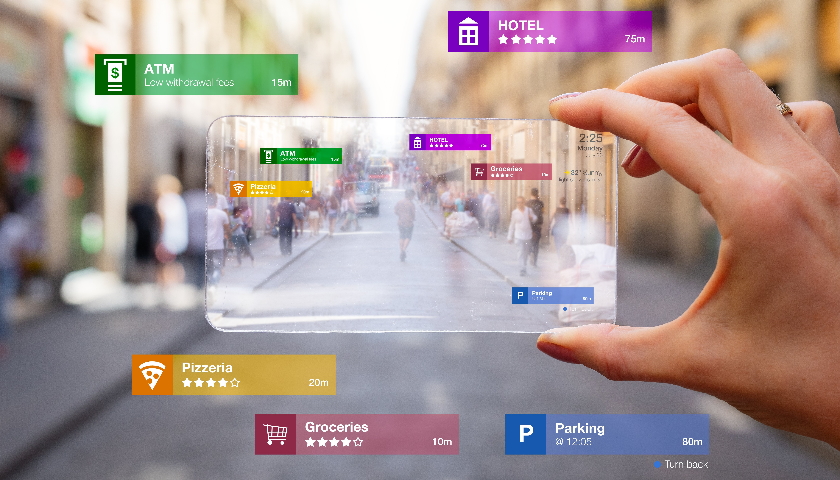Augmented Reality has captured the attention of various innovators and organizations over the years due to its practicality. It acts as a digital overlay capable of providing visualized real-time information to others. This piece of technology is rapidly improving and constantly evolving to transform the way we work, play and experience the world.
In the past, there was a disconnect between the wealth of data and its real-life application. While people are living in a 3D world, rich data and impactful insights are trapped on 2D screens. The gulf between them has limited our ability to reap the benefits from countless interconnected interactions and smart devices. However, what was once science fiction has now entered into the realm of immeasurable possibilities.
Its effects on users are undeniable: AR is engrossing, compelling, persuasive and most of all, immersive. It has shown great results in art, business, entertainment, healthcare, marketing and social networking. In the months and years to come, it will change how businesses engage with customers; train their workforce, develop offerings and make decisions.
Its simplest form is WebAR. There is no software requirement—it is already integrated into web browsers. This offers superficial experiences like replacing video call backgrounds or adding facial filters for some social media fun. In some cases, it reimagines the customer shopping journey. People can try on clothes by uploading a full body picture of themselves or test cosmetics and accessories on their face before purchasing.
When it comes to AR, the mobile phone is unquestionably the technology’s inseparable partner. These two were first paired in the early 2000s as a novel game for Nokia phones. Things slowed down until in 2016, Pokémon Go was launched—turning AR technology mainstream. There are now multiple ways to utilize AR mobile apps. Users can point their phones at an object to get real-time information, imagine how products look in their homes, superimpose GPS navigation onto real locations and create virtual copies of physical items.
The next leap in consumer AR technology is coming soon. Google and Apple have recently teased upcoming projects where both are moving towards wearable AR that may arrive in the form of glasses. Lighter than a VR headset, AR glasses provide quick access to glanceable information, view multimedia remotely, mirror a PC screen and offer readable subtitles for language translation on the go. Still in its infancy, AR glasses are creating an always-connected lifestyle while remaining hands-free even if you are in an office environment or for leisurely consumption.
It doesn’t take long to figure out that AR will eventually be the gateway into the early Metaverse. While there are lots of discussions of entering a virtual realm with VR, we are still barely scratching the surface with today’s technology. This is because creating a fully functional, highly interactive digital universe requires incredible processing power, elaborate hardware, huge amounts of data, edge networking and ultra-low latency. Without ticking any of these boxes, the immersive nature of the Metaverse will fall apart.
With that in mind, let’s shift our mindset. Instead of diving into the Metaverse with VR, let’s deliver the Metaverse to our reality with AR. While we can’t possibly alter the physical world, we can integrate an extra dimension to our surroundings. Rather than staring at the phone in our hand, the advent of AR glasses allows us to immerse in the amalgamation of the physical and virtual worlds. This means augmenting real life with rich digital content like spatial audio, pop-up text, interactive media and GPS data.
As AR technology continues to penetrate both realities, it affects every industry and modernizes traditional means of accessing information. During this paradigm shift, businesses need to tap into the boundless opportunities AR creates. The biggest advantage it provides is its ability to enhance performance across the value chain. From a business standpoint, AR can visualize, guide and accelerate product development, manufacturing processes, marketing campaigns, sales activities and logistics. When it comes to customer experience, it will uncover new ways to reach, engage, service and resonate with your audience.
At the end of the day, the endless possibilities created by AR can be overwhelming. Its rapid evolution may create unfounded fears of the unknown. However, humankind is one of the most adaptable creatures on Earth. Our flexibility, creativity and intuition are beyond the reach of machines. Simultaneously, the advances in digital and emerging technologies are unleashing new levels of productivity and value creation.
Instead of treating humans and machines like separate entities, uniting both will help us realize our fullest potential and achieve our vision of success. To do so, AR will be one of the most groundbreaking innovations that coalesces the physical and virtual realms.
So, get ready to put on your AR glasses and revolutionize the way you interact with the world.

